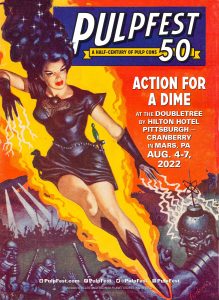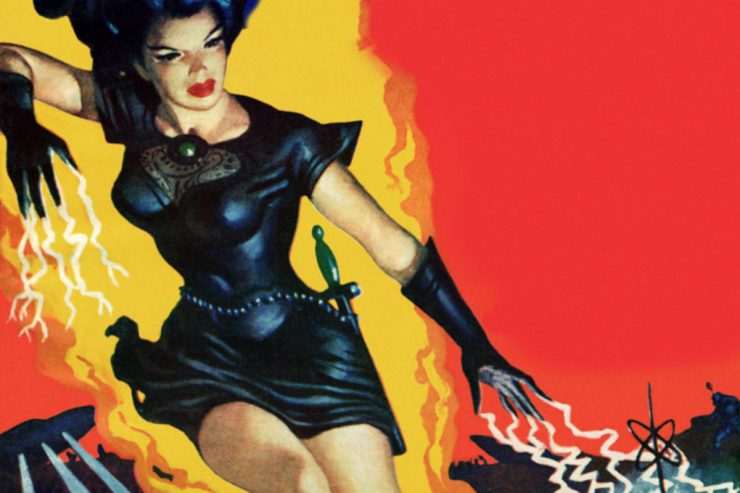Fifty years ago, there were no organized gatherings specifically geared toward pulp fiction and the magazines in which it appeared. That all changed when Ed Kessell, Earl Kussman, and Nils Hardin founded Pulpcon in 1972. This year we salute the fiftieth anniversary of that first pulp con — the convention now called PulpFest.

Although I didn’t grow up with the pulps, the first work of adult science fiction I read came from the pulp era — Aldous Huxley’s Brave New World. My academically-minded parents were no fans of fiction so I can’t explain why they had it and several other volumes of science fiction classics in their library. I read Brave New World way too young — at 13 — and it left a lasting, dark impression.
There was another story in those old volumes that stayed with me. It was a Rip van Winkle-type about a man who sleeps long and wakes up in the far future. I recall that all the people in that future world had no teeth and their plates chewed their food for them. I’ve searched long and hard for that story but with no luck. I thought it might have been an excerpt from Laurence Manning’s “The Man Who Awoke” (1933) but, although similar, it was still not quite right. Could lasting impressions from these early stories be the basis for my love of vintage science fiction? Partly, but it’s more complicated than that.
As you do in youth, I spent a long time looking for my artistic voice. I came to the pulps late and when I finally found them there was an immediate and almost supernatural click of rightness. Here were the stories I’d been looking for all my life. I began reading Henry Kuttner and C. L. Moore, then Edmond Hamilton and Doc Smith. And it just went on and on from there. I was struck by the sense of optimism in those early works of scientific romance and science fiction. It doesn’t matter to me that the science is dated and the social morals, stiff. Those were products of the time and I see no harm in them.
The important thing for me is that the pulp writers had their eyes uplifted to the sky. All too often today our eyes are held downcast, especially after the last few years. How do we reshape the future from here? I think we can all profit by some of those early fictioneers’ cock-eyed optimism.
My mother, a professional writer and editor, once told me that when I found the thing I really wanted to write I’d start writing and never stop. She was right. For me, it’s new pulp — science fiction so far but I suspect I’ll try my hand at other genres — pulp fantasy, love stories, and perhaps horror in the future. As a pulp historian, I love writing about the history of the pulps. I even enjoy writing book reviews from time to time.
I have a Master’s Degree in Scientific Illustration from one of the most prestigious programs in the country. For more than 30 years Donald Sayner trained some of the best scientific illustrators in the United States. I was honored to be his student and later, teaching assistant. From him, I learned the same techniques the old pulp illustrators used — pen & ink, scratchboard, coquille, watercolor, and gouache. (I had already learned oils in college and from my father, himself a fine painter.) So when I look at a pulp illustration from the old days I feel as if I’m looking at the work of a peer.
I continually study pulp art with two goals in mind. The first is to recreate it accurately for my own books. The second is to preserve the techniques, possibly to teach them later on.
I feel the same way about pulp writing. I study it to try to understand the feeling and flow of the words and stories. My goal is art, really. I want my illustrated books to give you the feeling that you’re reading the best of the old pulps with new stories and art. Some people say that I’m succeeding but time will give the final verdict.
Why PulpFest? It’s an immersion. As with any niche convention, you’re surrounded by people speaking the same language. There’s no need to explain about a popular author or artist when talking to vendors. They already know! And probably know much more about the subject than you do. You’re rubbing elbows with professionals in all fields, very bright and interesting people. The presentations are always inspiring and I learn a lot from them. And the chance to see original artwork is simply outstanding. There are things you can see in the original art that you just can’t make out in reproductions.
The pulp historian in me looks across the dealer room and thinks — all these people have stories and I want to find out what they are. Of course, you can’t talk to everyone but there are good conversations every few feet. And you never know who will become a new friend, colleague, or even business partner. It’s always a fun time and I’m always dragging my heels when the taxi comes to take me to the airport and home.
If you love the pulps then coming to PulpFest is a no-brainer. See you in August at Pulpfest 50.
You can become a member of PulpFest 50 by clicking the Registration button on our website. If you need lodging, you can also book a room on our page.
A professional journalist and illustrator with over thirty years of experience, Sara Light-Waller is an accomplished new-pulp fiction author/illustrator with two books out and more on the way. She is also the winner of the 2020 Cosmos Prize for her illustrated short story, “Battle at Neptune.” A huge pulp fan, Sara is especially fond of science fiction pulps. The extent of her pulp fandom can best be measured by the oversized rendition of Frank R. Paul’s August 1928 Amazing Stories cover that she painted on her garage. Sara is a member of the PulpFest organizing committee and a regular contributor to our website and The Pulpster.
At PulpFest 50, Sara will be discussing “Planet Stories and the Romance of Space.” Hence, it seems appropriate that our postcard image has been adapted by PulpFest advertising director William Lampkin from Allen Anderson’s cover for the March 1952 issue of the Fiction House pulp, Planet Stories.
Join pulpfest.com on February 28 when Tony Davis, the longtime editor of The Pulpster and winner of the 1999 Lamont Award, answers the question, “Why PulpFest?”







